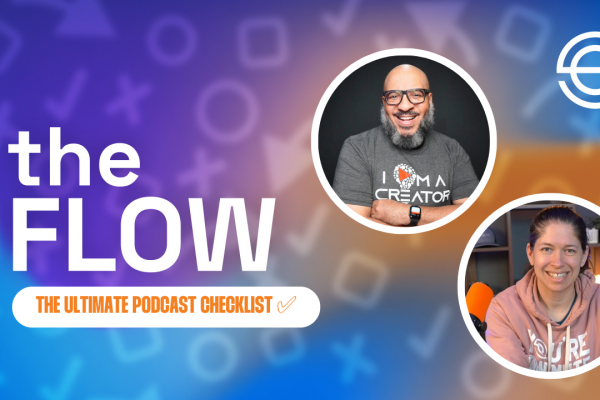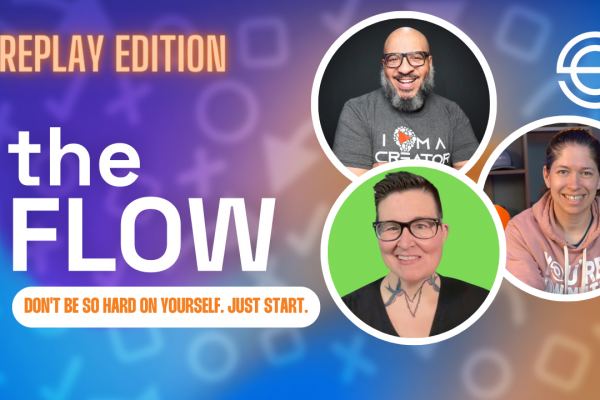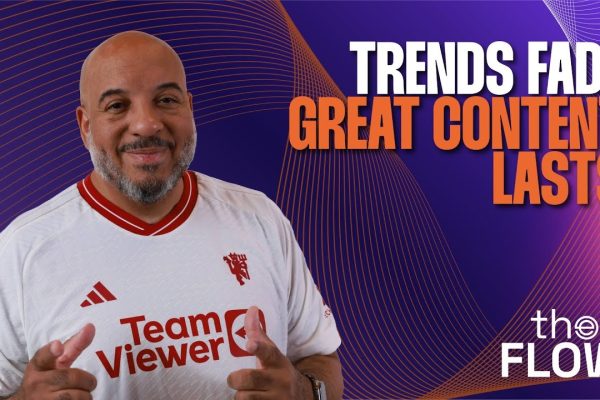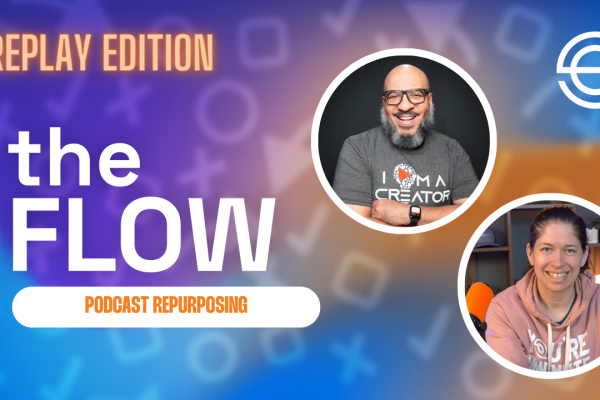Chances are you have listened to a podcast. Maybe you even have a rotation of your favorites that you listen to on a regular basis. Podcasting has been around for years now and continues to grow in popularity. And now many podcasts are also moving into the world of video, too.
But what is video podcasting? And what makes it different from live streaming or podcasting? Why should you bother? If you’ve been wondering if you should add video to your podcasting workflow or thinking a video podcast is for you, then you’re in the right spot.
In this article, we’re talking about:
- What is video podcasting?
- How is video podcasting different from live streaming?
- What are the benefits?
Watch the video podcast episode
Catch The Flow by Ecamm live every Tuesday at 12pm Eastern on YouTube and audio-only episodes on Tuesdays on your favorite podcast platform.
Shownotes and episodes available at flow.ecamm.com
What is video podcasting?
A lot of people are going to be under the assumption that video podcasting is new, but it’s not. If you go back to when you got your podcast from iTunes, there used to be a button to separate the video podcast from the audio podcast. Apple was very focused on that at one point.
When you launched it, the pages would load. And you’d see all of the icons like you see today, but across the top would be the most popular video podcasts that are out there. One of them was TWiT, for example. What Apple realized, about the time Serial came about and broke the mold on podcasting, was that they maybe didn’t want everything separated out.
At that time, there were about 10% of podcasters who were also doing video. That is until YouTube and other platforms brought video shows to the forefront and companies like Ecamm made live streaming software easier to use and much more accessible.
This led to a ton of growth for video podcasts. And now the space is starting to merge back up with audio podcasts again. As if the technology has finally caught up with the idea.
The main thing to understand is there’s not a big difference between a video podcast and an audio podcast. By adding video, you’re expanding your audiences and your ability to grow. Instead of just having listeners, you can also add on viewers (and if you add in streaming you can split viewers into live viewers and replay viewers).
Embracing a Live to Tape Workflow
If you can get into a live to tape workflow, you’ll also be able to reach multiple audiences with pretty minimal repurposing work. Start by going live and you’ve reached live viewers. Leave the video up on YouTube and you’ve hit the replay viewers now, too. Grab the audio and send along to your podcast host and you have audio listeners in the bank. AND if you grab the transcript and turn it into a blog post, you’ll also reach readers and improve your SEO.
And you’re able to use that content in a lot of different ways. You’re doing the work once and you’re able to do a ton with that content versus recording a video, editing the video, uploading the video, and then being like, oh, now I need to record the audio podcast version of it. Oh, now I need to write a blog post.
If you can get into the flow of starting live (or even starting with a recorded video), you’ll be done. You won’t need to do a lot of editing or redoing the content in different formats. So in the world of podcasting, it is easier to start with video first.
What Makes Video Podcasting Different From Live Streaming?
Video podcasting and live streaming are similar. The difference is in your intention. With a live stream, you can structure it however you’d like. You can chat throughout the stream with your audience or do a live Q+A. The flow of your content (or what we call a run of show) isn’t going to matter as much… unless you’re planning on repurposing that video content.
With a video podcast, you are definitely going to be repurposing your audio, so you have to be thinking about both your viewers and your listeners. You aren’t going to want to be showing a ton of things on screen because then your podcast listeners aren’t going to know what’s going on and they’ll stop listening. Your intention needs to be on both audiences.
For video podcasts, we typically set up a really rigid run of show, especially if you’re going with a live to tape structure. If you’re streaming first, you’ll want to keep house keeping and interaction with your live audience to the beginning and end of your show. This way, you can easily trim those bits off so that you’re not antagonizing your replay viewers and podcast listeners who weren’t live with you.
So the format or the run of show needs to reflect your intention upfront before you go live, otherwise you’ll mess up the flow. And then it won’t be easy to repurpose that content later. Having that structure, having that run of show, lets us not have to do a ton of editing on the other side, which is a win for everyone.
One thing you may not have thought about (but should) is your video transcript. There are some great tools out there that will let you take your recording and generate a full text transcript. You can use this for your podcast’s shownotes, to use to create a blog post, and even for closed captioning. Descript is a great option if you’re looking for our recommendation.
Since search engines like Google can’t see videos (or hear audio), having shownotes, a blog post, and captions are a great way to make sure your video podcast is discoverable. Not to mention that it opens you up to a new audience – readers!
They’re always looking for natural language and natural language flow. People also tend to type out questions. The way that they talk, which is why, when we do a live stream, we have to tell people, oftentimes, can you please rephrase the question? Because they said in as if you could hear them to answer them back and you would catch the contact and the inflictions with the voice to text capabilities.
What are the Benefits to Video Podcasting?
There are lots of great benefits when it comes to video podcasting. Here are our top three:
- Build a community by starting with live video.
- Save yourself time and create efficiencies by setting up a repurposing workflow up front.
- Make tweaks and edits easier by leveraging visual markers.
Building a Community
Live streaming your podcast allows you to grow your community and get immediate feedback from your viewers. Not only will you make those live viewers feel special, but you’ll also be able to take their questions and feedback and use that information to make updates to your episode topics or show flow.
Save Time & Create Efficiencies
A live-to-tape video podcast workflow means that all of the work is actually in the planning phase. Once you go live (or record), you’ll have the finished piece of content that you can repurpose into audio only for podcast hosts, text only for a blog post and/or shownotes, and shorter video clips you can leverage across social media. No need for heavy editing or reshoots. Come as you are and stop over thinking it all.
Make Tweaks Easily
Video podcasting makes it much easier to make tweaks and small edits. After all, in video you can see your markers quickly. Make a mistake during recording or live streaming? No worries. Just hold up your hand or put an overlay on screen so that you know exactly where to trim or edit.
Video Helps Tell a Story & Build Connection
One of the reasons why video podcasts took off doing the pandemic is there are a lot of people who were separated from their families or they weren’t able to spend time with friends and colleagues. So everyone started connecting with one another virtually.
Watching videos on YouTube can feel like spending time with friends. Hosts are welcoming you into their studio space or their homes or even kitchens and sharing their experiences. It feels friendly and personal.
Here’s a great story from Doc Rock:
Before I went on my vacation to Seattle, Karen’s mom would watch all myriad things on TV. Then I got her a YouTube Premium account and the TV just went off. Here’s a 76 year old lady. English is her second language. And she watches YouTube more than regular television.
Why? Because she can find her people there. She can find other Okinawans. She can find content that she relates to. One night, I was grading a live stream for one of my coaching clients and Karen’s mom saw the stream. She fell in love with Dina’s stream. And so now she’s like, when are you gonna live screen with Dina? She says “live screen” instead of “live steam”. It’s adorable. And I’m like, what are you talking about? But when we went to meet Dina in person, it was a huge thing for Karen’s mom. Now she has a physical connection to Dina. Yeah. And so when she watches the stream, now she is yelling at the TV and giving Dina tips in the kitchen or telling her, oh, I didn’t know that. Thank you, Dina. And she’s having a full conversation with Dina.
People care a lot more about the content and the authentic relationship than they do about your hair or your makeup or your clothing or everything. So, yeah, don’t overthink that to death.
Get Into The Flow with Ecamm
Want to catch The Flow live? Join us every Tuesday at 12pm Eastern on YouTube or listen wherever you get your podcasts.
If you have any questions for us, please send them to flow@ecamm.com or join us live.





